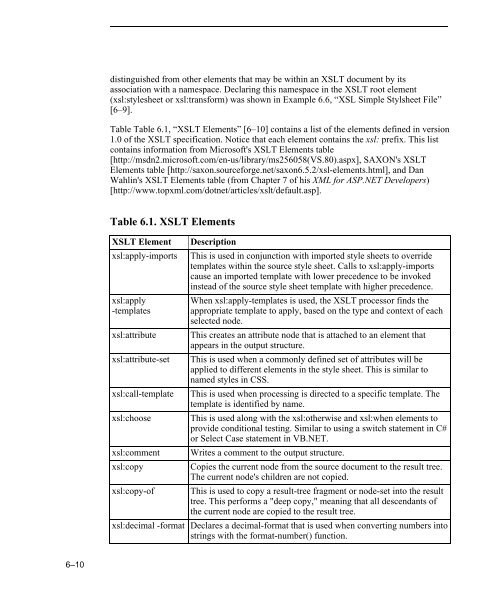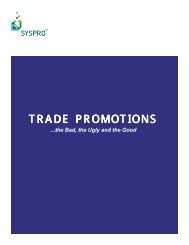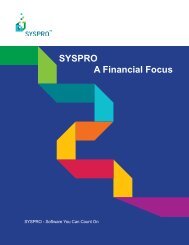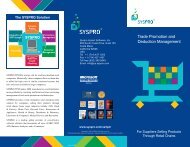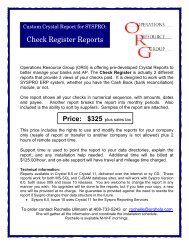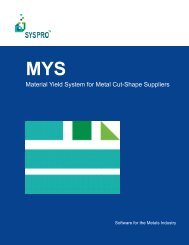Teach Yourself e.net - Syspro
Teach Yourself e.net - Syspro
Teach Yourself e.net - Syspro
Create successful ePaper yourself
Turn your PDF publications into a flip-book with our unique Google optimized e-Paper software.
distinguished from other elements that may be within an XSLT document by its<br />
association with a namespace. Declaring this namespace in the XSLT root element<br />
(xsl:stylesheet or xsl:transform) was shown in Example 6.6, “XSL Simple Stylsheet File”<br />
[6–9].<br />
Table Table 6.1, “XSLT Elements” [6–10] contains a list of the elements defined in version<br />
1.0 of the XSLT specification. Notice that each element contains the xsl: prefix. This list<br />
contains information from Microsoft's XSLT Elements table<br />
[http://msdn2.microsoft.com/en-us/library/ms256058(VS.80).aspx], SAXON's XSLT<br />
Elements table [http://saxon.sourceforge.<strong>net</strong>/saxon6.5.2/xsl-elements.html], and Dan<br />
Wahlin's XSLT Elements table (from Chapter 7 of his XML for ASP.NET Developers)<br />
[http://www.topxml.com/dot<strong>net</strong>/articles/xslt/default.asp].<br />
Table 6.1. XSLT Elements<br />
XSLT Element<br />
xsl:apply-imports<br />
xsl:apply<br />
-templates<br />
xsl:attribute<br />
xsl:attribute-set<br />
xsl:call-template<br />
xsl:choose<br />
xsl:comment<br />
xsl:copy<br />
xsl:copy-of<br />
Description<br />
This is used in conjunction with imported style sheets to override<br />
templates within the source style sheet. Calls to xsl:apply-imports<br />
cause an imported template with lower precedence to be invoked<br />
instead of the source style sheet template with higher precedence.<br />
When xsl:apply-templates is used, the XSLT processor finds the<br />
appropriate template to apply, based on the type and context of each<br />
selected node.<br />
This creates an attribute node that is attached to an element that<br />
appears in the output structure.<br />
This is used when a commonly defined set of attributes will be<br />
applied to different elements in the style sheet. This is similar to<br />
named styles in CSS.<br />
This is used when processing is directed to a specific template. The<br />
template is identified by name.<br />
This is used along with the xsl:otherwise and xsl:when elements to<br />
provide conditional testing. Similar to using a switch statement in C#<br />
or Select Case statement in VB.NET.<br />
Writes a comment to the output structure.<br />
Copies the current node from the source document to the result tree.<br />
The current node's children are not copied.<br />
This is used to copy a result-tree fragment or node-set into the result<br />
tree. This performs a "deep copy," meaning that all descendants of<br />
the current node are copied to the result tree.<br />
xsl:decimal -format Declares a decimal-format that is used when converting numbers into<br />
strings with the format-number() function.<br />
6–10


